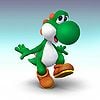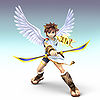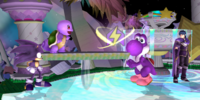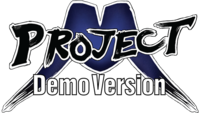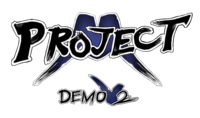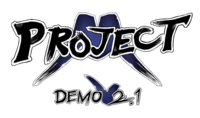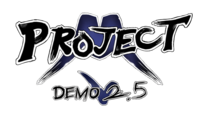Project M
Project M is a mod for Super Smash Bros. Brawl designed to make the gameplay more closely resemble that of Super Smash Bros. Melee mainly, and also Super Smash Bros. to a lesser extent. This means that the speed of gameplay has been generally increased, with many Melee mechanics being restored. The development team is partly descended from the original developers for Brawl+, now known as the PMBR, or Project M Backroom. It has members from over ten countries, though as of now, only an NTSC version has been released.[1] Project M's character roster notably includes Mewtwo and Roy (two characters that were playable only in Melee and not in Brawl) with altered graphics and movesets.
Project M is commonly featured as an event at tournaments including several national tournaments, such as GENESIS 2, the Zenith series, and Apex 2014. Starting around 2012-2013, Project M saw a rapid rise in its popularity as more characters became playable and the mod was featured more commonly at Smash tournaments; the number of entrants for Apex 2014's PM singles event notably surpassed the amount of entrants for the original Brawl.
Universal changes
The actual version of Project M has two versions: Full Set and Wi-Fi. The former has Stock Control and Input Assistance as new features, which allow newer players to use advanced techniques better and have a stock advantage over experienced ones. However, Replays and online play won't work properly; if a Project M replay is viewed on the regular Brawl, it may cause malfunctions when beginning a match, possibly because of the stage replacement. The Wi-Fi version allows these two things to work properly, and while it keeps the former version's battle features, these are not implemented for online play, likely because Stock Control would have caused potential griefing within matches (by the distant opponent always choosing the maximum amount of stocks).
Both versions heavily alter the original Brawl gameplay to more closely resemble that of Melee, along with other changes to make the game more competitive in general, while keeping other Brawl beneficial techniques such as crawl, wall cling or DACUS.
Melee based changes
The following mechanics have been altered to match their Melee forms:
- General amount of freeze frames reduced.
- All characters have faster falling speeds and gravity, and more forwards momentum from a dash is conserved when jumping.
- Air dodging applies a directional boost and causes helplessness, making it generally riskier for midair combat, but allowing faster midair movement within short ranges and restoring the wavedash techniques vital for most characters' metagames.
- L-canceling halves landing lag when a shield button is pressed 7 frames before landing, thus reinstating the SHFFL technique, bolstering characters' midair movement and allowing much better usage of combos. A brief white flash on the character is additionally displayed when an attack is correctly L-canceled.
- Dash dancing's timing has been reverted, making it longer and more practical, and characters can shield during one.
- Crouching cancels dashes, allowing quicker, more varied options after dashing.
- Crouch canceling reduces knockback, and hitting the C-Stick down while crouching uses a down smash (in Brawl it used a down tilt), allowing to efficiently counter opponents by crouching.
- Consecutive jabbing is removed.
- Double jump canceling reimplemented; its usage varies slightly between characters.
- Ledge teching reimplemented, again giving recovering characters the possibility to survive at ludicrous damages by DIing toward a ledge and teching into it upon being attacked. Ledge-canceling is once more possible as well.
- Jumps can be canceled with grabs, so regular grabs can still be effectively used after a dash, avoiding the usual ending lag of a dash grab.
- Powershielding can reflect projectiles during the first 2 frames.
- Shieldstun formula reverted. Like in Melee, characters now also take longer to act out of a shield drop (almost twice as in Brawl), causing the gameplay to be less defensive-focused.
- Ledges cannot be auto-sweetspotted, so they cannot be grabbed neither from the back, nor during the attacking portion of recovery attacks. Some moves like Raptor Boost or Bowser Bomb still use this feature, though. Additionally, characters can act out of a ledge grab sooner, and when performing a rolling get-up, other characters cannot grab it until the animation is finished, thus making edge hoping and edgehogging easier.
- Hitstun canceling has been removed, causing overall horizontal survivability to be shorter, but giving characters more extensive combo options, which were almost nonexistent in Brawl. Air dodges are no longer usable when tumbling.
- Window for teching reverted, making it generally easier to perform.
- Items cannot be grabbed during dash attacks or aerials.
- Grab aerials cause helplessness if they miss a ledge, but can be used after an air dodge with the shield + attack combination. They still act as tether recoveries, though they won't restore a character's midair jumps if they drop from the ledge.
- If an already-struck character gets hit by something else, the new knockback either replaces the old knockback (if the gap between the attacks was 10 frames or less) or has its direction and power combined with the old knockback (after 10 frames). In Brawl, whether to replace the old knockback is based on the relative power of the two attacks, and no merging is performed.
- Brawl's random input delay is fixed.
- Meteor smash angle reverted, thus implementing the superior, more efficient spikes.
- When dash grabbing a foe, forward momentum is completely negated. Unlike in Melee, though, characters with low traction still possess this feature.
- Grab released characters will get back their midair jumps.
- Pummels reverted to all having the same standarized speed and dealing 3% damage per use, with only a few exceptions.
- Grab physics reverted: characters can grab opponents behind them, though they cannot be grabbed by the lower legs or arms.
- Characters hit when lying on the floor will bounce shortly and then get up automatically upon landing, or will assume their falling animation if they bounce too high or away from the platform, removing locks, but allowing opponents to perform jab resets.
- Though a barely noticeable change, smash attacks can now be charged for 59 frames as opposed to 60, and a fully charged smash deals x1.3671 of the uncharged amount.
- Phantom hits now inflict damage equal to half the damage an attack would have done, and while they don't produce any knockback and require a smaller part of the hitbox to connect, they cause the opponent (and not the attacker) to enter hitlag, can be SDI'd, and the real hit can still connect afterwards.
Brawl based changes
Aside from Melee restorations, the following techniques and mechanics from Brawl have also been changed:
- Footstool jumping is done with a taunt input.
- Tether recoveries now ignore edge-hoggers; characters will still grab the ledge without affecting them, and when pulled up they will perform an automatic jump get-up. This gives characters reliant on this technique a much better and safer recovery, and makes them harder to punish.
- Random tripping has been removed. Forced tripping is kept, but only for attacks that always cause it. Tripping can additionally be teched, so punishing a tripped character is more tech chase-orientated.
- Meteor canceling revamped: after being struck, all characters must wait for 16 frames before meteor canceling. Attempting to do this earlier results in the character not being able to meteor cancel during the entire hitstun of the attack (except if a jump input isn't used).
- The grab release glitch has not been removed: though characters now regain their midair jumps, the new physics now also cause this glitch to disable the ability to air dodge, still leaving characters affected by this glitch dangerously exposed against edgeguarders.
- A glide toss can be done in midair with an air dodge. Additionally, air dodges still auto-grab items during the first frames of execution as in Brawl, so that item-based attacks are easier to counter.
- Gliding is no longer usable with a jump button: a special move must be used instead to do so.
- Super armor has been removed. Standardized knockback resistance system categorizes armor as Light, Medium, or Heavy. Some characters feature color overlays to indicate such armor, with more opaque overlays generally indicating stronger armor. If an attack's knockback is lower than the specified amount of an armor, no knockback is inflicted, but if it is higher, knockback will be regularly inflicted as usual.
- Buffering now works differently: the game normally has no buffering, like in Melee, though players can turn on Input Assistance to implement a 3-frame buffer window for helping newer players master advanced techniques, replacing the "Damage Gauge" option. Online matches instead have a different Buffer option that replaces handicaps, from 1 to 30, with these numbers being the respective amount of buffer frames.
- Special Brawl's "Curry Mode" is replaced with "Turbo Mode", in which all moves can cancel into any other move or action on hit or on shield. Superspicy Curry is replaced with a "Turbo" item that causes characters to act like in Turbo Mode for a short period.
Other changes and gameplay tweaks
- Smash 64's taunt canceling returns.
- Stages such as Dream Land, Hyrule Castle and Fountain of Dreams replace stages such as Bridge of Eldin and 75m.
- Stock Control added, replacing handicaps. Players can now control the amount of stocks each player starts with before battle, from 1 to 30 stocks for each individual character. A Crew mode has been added in which the game keeps track of stocks retained after battles.
- Stage selection menu modified to include built-in stage striking control (Full Set version).
- L and R Buttons for the GameCube controllers were tweaked so that the player can input any actions requiring them by just light-pressing them, rather than pressing all the way down, making easier to use techniques such as wavedashing, L-canceling, or even shielding itself (due to Project M's lack of lightshields).
- New Melee-like designs for the menu and character selection screens, with altered writing.
- The game in general takes less time to load modes, characters and scenes, and things such as Records can be scrolled through quicker.
- Brawl mode is now labeled as "Fight!", and all other modes and sections containing "Brawl" are replaced with "Smash" (such as Multi-Man Brawl being named Multi-Man Smash).
- Default match type is 4 stock with an 8-minute timer, and Team Attack is turned on by default, similar to the settings of usual competitive Melee matches.
- The timer during matches is placed at the top center of the screen rather than at the top right.
- Altered camera that behaves similarly to in Melee's Camera Mode, as well as being capable of zooming out indefinitely and rotating around the entire stage, allowing to unrestrictedly take snapshots.
- Stage selection screen revamped: stages are now ordered at the bottom in a rectangular shape, with the selected stage being displayed at the top. Stages are now also ordered in Pages 1 and 2, and the top background displays Project M.
- Victory screen for VS. battles altered to be entirely black like in Melee.
- Independent character icons for Zelda/Sheik and Samus/Zero Suit Samus.
- Characters now grunt instantly when hit by a strong attack, as in Melee and 64, while in Brawl they did a second afterwards. There are also medium-damage and high-damage groans as well, with most characters using unused voice samples from the Sound Test. Characters now also use voice samples for sidesteps and air dodges, and variable voices for smash attacks.
- Smash Taunts were introduced to more characters, such as Ness and Link, though these are less involved and can be done on any stage.
- Characters now emit a spark when wall jumping.
- The cast of characters and background at the beginning of the opening movie is slightly altered, and both it and the title screen now display "Super Smash Bros. Project M".
- Mewtwo and Roy were added as opponents for All-Star mode.
- Training mode now appears as the default Solo mode, and after entering it, the same characters that participated will appear chosen automatically for Group battles.
- Home-Run Contest stadium no longer has a protective window, acting like its Melee counterpart. Its online competitive mode has also been added as a co-op mode offline, with records being saved.
- No Replay time limit.
- Many additional costumes are added for each character, and are shown on the characters profiles as "Colors". There are now also "Special" costumes for some characters, such as Dr. Mario for Mario, Shadow Queen Peach for Peach, and Armored Mewtwo for Mewtwo, some of which get team colors and changed aesthetics.
- Due to issues with slow motion, Timers are removed and replaced with ordinary stickers, even for Training mode. Poké Ball Pokémon are also changed slightly: Latios & Latias deal half their usual damage, and Weavile no longer stuns opponents, instead sending them on a weak upwards trajectory. Other items remain unchanged, though, aside from a few Final Smashes.
- CPU players have a much more advanced AI, with higher technical skill.
Characters
In addition to many universal changes, individual characters all received adjustments. Characters were largely buffed overall, creating a broad collection of viable characters with varying play styles, strengths, and weaknesses. However, some moves were nerfed to further flesh out certain fighters and break dependence on repeated use of a single move or set of moves. Some Project M characters are based on their Melee versions (such as Captain Falcon and Jigglypuff) while others are modified from their Brawl versions or a mixture of their iterations from both games. The sourcing of previous versions of a character depends largely on previous attendance and performance, with high tier Melee characters all being reverted to their past formats. This includes special and normal moves, properties such as gravity, weight, run-speed, and air mobility but does not include sound effects, textures, or vertexes. Some characters, due to having poor attributes and movesets in both Melee and Brawl (such as Bowser, Kirby or Zelda), had their positive attributes from each game merged and were given entirely new buffs.
List of characters
* Characters not in Brawl
Stages
| Stages | |||
|---|---|---|---|
| Stage | Changes | Stage | Changes |
 Battlefield |
Stage layout slightly tweaked to match Melee's Battlefield. |  Big Blue |
|
 Brinstar |
 Castle Siege |
Second area removed. | |
 Corneria |
File:ProjectM DraculasCastle.png | Replaces Luigi's Mansion. A large stage that takes place on the roof of a medieval style castle with three platforms. The platforms move around during play, taking on various configurations and sometimes disappearing altogether. The stage is set at night with a view of the castle in the background, and there are walls down to the lower blast line that can be used for walljumping when returning. | |
 Dream Land |
Replaces Green Greens, as well as "Fountain of Dreams" theme with Smash 64's Dream Land theme. | 
|
Not to be confused with Brawl's Distant Planet, this stage was originally an arena from SSE: Jungle, but was redone with a Pikmin theme. It consists of a large base and four platforms, the outermost of which are slightly raised leaves that hang over the main platform's edges and will droop when stood on. |
 Final Destination |
Reverted to Melee's version to fix issues with getting stuck underneath Brawl's edges when returning. |  Flat Zone 2 |
|
 Fountain of Dreams |
Replaces Mario Bros., as well as its theme song with Fountain of Dream's. |  Fourside |
Replaces New Pork City, and replaces "Porky's Theme" with Fourside's. |
 Frigate Orpheon |

|
Redone entirely. It is now a medium sized stage with a proper bottom blast line and no hazards or breakable sections. There is a single moving platform which rotates around a central point above the main platform. | |
 Halberd |
Raised ceiling and removed claw. |  Hyrule Castle |
Replaces Bridge of Eldin. Also replaces "The Hidden Village" theme with Hyrule Castle's. Tornado hazards removed. |
 Jungle Japes |
Water cannot be swum in. |  Congo Jungle |
No Barrel Cannon. Replaces 75 m. Also replaces "25 BGM" theme with Congo Jungle's. |
 Lylat Cruise |
Stage doesn't tilt. |  Meta Cavern |
Remade Meta Crystal, replaces Mushroomy Kingdom. Also replaces "Ground Theme (Super Mario Bros.)" theme with Meta Crystal music from Smash 64. |
| File:ProjectM Norfair.png Norfair |
Different layout with three slowly moving platforms and all hazards removed. |  Onett |
|
 Pictochat |
Some transformations removed. Some previously impassable platforms can now be passed through. |  Pirate Ship |
Hazards made weaker. |
 Pokémon Stadium |
Windmill during water stage moved to the background, edges tweaked to let characters recover more easily. |  Pokémon Stadium 2 |
No stage transformations. Center platform has a Master Ball drawing, and small televisors at the background display "Project M". |
 Princess Peach's Castle |
No block switches nor Banzai Bills. Replaces Mario Circuit and its theme with Princess Peach's Castle's. |  Rainbow Cruise |
Donut block lifts can be passed through like in Melee. "Princess Peach's Castle" theme is replaced with Mushroom Kingdom II's from Melee. |

|
Completely redone without scrolling. Neutral stage with a main platform and three smaller platforms in an unusual configuration. |  Saffron City |
No Pokémon spawn. Replaces Spear Pillar, as well as "Victory Road" theme with Saffron City's. |
 Shadow Moses Island |

|
Features a large base platform with stairs and two raised platforms, one of which is quite large. Features parts of Temple. Replaces Hanenbow, using "Hyrule Field Theme". | |
 Skyworld |
Main platform made unbreakable and other platforms made into clouds. |  Smashville |
|
 Summit |
 Temple |
||

|
Large stage with checkered surfaces, a wall at the left and a pit at the right, designed with a lot of open area for practicing. Features a sandbag that respawns in the middle when knocked out. Replaces Online Practice Stage. |  Warioware |
Microgames removed. |
 Yoshi's Island |
 Yoshi's Story |
No Fly Guys. Replaces Yoshi's Island (SSBM), as well as "Super Mario Bros. 3" theme with Yoshi's Story's. | |
Turbo Mode
As of version 3.0, the Curry effect is replaced with a new one - Turbo. In Turbo mode, players are able to cancel any successful attack, upon hit or shield, into any other action except the same attack, and all aerial attacks auto cancel when landing, if they hit. Certain moves, such as Farore's Wind, consist of multiple actions and can be canceled into themselves. Turbo Mode has been compared to the Marvel vs. Capcom series, because it enables skilled players to perform extensive combos.
Turbo mode can be selected from the Special Brawl menu, or temporarily granted by the "Turbo" item, which replaces Superspicy Curry.
Notable Turbo-related resources:
- The official Turbo Mode blog post.
- Melee Impossible, the original inspiration for Turbo Mode.
- The official Turbo Tuesdays playlist, beginning with the April Fools video that revealed Turbo mode.
- Going Turbo, by Sethlon. The first Turbo combo video to feature no tool assisted inputs.
Tier list
While an official tier list has yet to be published, a preliminary list has been posted by CLASH Tournaments on Marth 26th 2014.
| Project+ Official Tier List v4 [2.29] | ||||||||||||
|---|---|---|---|---|---|---|---|---|---|---|---|---|
| S | A+ | |||||||||||
| 1 | 2 | 3 | 4 | 5 | 6 | 7 | 8 | 9 | ||||
| 1.82 | 2.18 | 2.64 | 5.36 | 6.18 | 7.73 | 8.64 | 8.91 | 9.00 | ||||
| A | ||||||||||||
| 10 | 11 | 12 | 13 | 14 | 15 | 16 | 17 | 18 | 19 | 20 | ||
| 11.45 | 12.00 | 12.45 | 13.09 | 13.64 | 14.73 | 15.18 | 16.09 | 17.00 | 18.27 | 20.09 | ||
| B | ||||||||||||
| 21 | 22 | 23 | 24 | 25 | 26 | 27 | 28 | 29 | 30-31 | 32 | 33 | |
| 22.73 | 23.55 | 24.18 | 24.27 | 26.18 | 26.91 | 27.55 | 28.36 | 29.45 | 29.82 | 29.82 | 30.45 | 31.09 |
| C | D | |||||||||||
| 34 | 35 | 36 | 37 | 38 | 39 | 40 | 41 | 42 | ||||
| 34.36 | 35.09 | 35.27 | 35.64 | 35.73 | 37.18 | 38.82 | 40.27 | 41.09 | ||||
Release history
Demo 1.0
Released February 8, 2011
- 14 characters available
Demo 2.0
Released April 17, 2012
- Added 15 characters
Demo 2.1
Released May 23, 2012
- Major bug fixes
Demo 2.5
Released December 29, 2012
- Added 4 characters
- Ledge teching implemented
- Melee knockback stacking implemented
- Input Assistance and Stock Control implemented
- New aesthetic changes which include new palette swaps and new menu designs.
Demo 2.5b
Released January 6, 2013
- Various Minor Bug Fixes
Demo 2.6
Released July 17, 2013
- Added 1 character
The PMBR announced Project M 2.6 along with their new website design.
Demo 2.6b
Released August 15, 2013
- Various Bug Fixes
v3.0
Released December 9, 2013
- Added 7 characters
- Turbo mode added.
- Princess Peach's Castle added, Norfair revamped, Distant Planet revamped, Training Room stage added.
- Numerous alternate costumes for several characters added, including Dr. Mario.
- Shedding of "Demo" title, now an official mod.
- Formerly, an April Fools' video[2] announced that 3.0 would contain a universal gameplay change where all moves can cancel into any other move or action on hit or on shield. While the change being universal was a joke, it finally became available for play as "Turbo Mode" in Special Brawl, replacing the "Curry" option. Project M 3.0 also marks the first version to contain the entire Brawl roster, along with Roy and Mewtwo, and features many new alt costumes, such as Dr. Mario as an alternate skin for Mario, akin to Wario's biker and plumber skins. Other skins are: Melee Fox, Shadow Queen Peach, Ocarina of Time Link, Dry Bowser, Party Hat and Pirate Hat Pikachu, Crown and Fairy Jigglypuff, Armored Mewtwo, Mr. L, Virtual Boy R.O.B., Outset Toon Link, Classic Wolf, Boxer Donkey Kong, Pajama Ness, Masked Man Lucas, Fire Peach, additional Yoshi colors, Melee Falco, and Concept Art Meta Knight.
v3.01
Released January 11, 2014
- A new launcher is released with the following features:
- Support for SDHC cards larger than 2GB (Hackless method still limited to 2GB, unless Letterbomb is used.)
- A news ticker will display current news for Project M which will update if your Wii is connected to the Internet.
- The ability to update and patch both the Launcher and your version of Project M. If you have 3.0 installed on your SD card, the Launcher can automatically download and update you to version 3.01.
- Extremely fast and reliable file loading.
- Fixed the lag from the imported models such as Roy, Mewtwo and the alternative costumes.
- Salty Runbacks implemented. Holding L+R+Y at the end of a match, or L+R+A+Y+Start at the pause screen, will cause the match to restart instantly. This feature is not available on Pokémon Stadium 1, Lylat Cruise, or Castle Siege. Similarly, it's possible to abort a stage loading by holding L+R+A, as in Melee, but faster loading times make this more difficult to perform.
- Various bug fixes, including (but not limited to) the following:
- Roy's Final Smash is reworked, and no longer causes game-breaking glitches.
- Many of Kirby's copy abilities updated.
v3.02
Released January 13, 2014
- Various Bug Fixes
Errors
Despite having numerous updates over time, Project M still experiences some minor errors (i.e. bugs and faults) outside the regular Versus modes, which include:
- Because the single-player Roy and Mewtwo assets are incomplete as of 3.0, when completing Classic or All-Star with a character, the trophy shown will always be that of Mario (though when viewing in the Vault, characters will still have their trophies collected as usual), and the FMV after the Character Roll Call will always be that of the Subspace Emissary introduction.
- To avoid freezes (the assets for the alternate costumes and Roy/Mewtwo are incomplete), trying to play tourney will make the player go to Rotation instead.
- Though the Pokémon Trainer's Pokémon will still have records saved for him, they cannot be viewed unless the regular Brawl is booted up.
- To avoid freezes (with saves early in the mode), trying to play the Adventure Mode will make the player go to Training mode instead.
- Because of temporary incompatibility with Project M's new frame speeds, slow motion is incredibly buggy. Players who are slowed exhibit many odd behaviors. The effects are brought on when a player is slowed from a timer. Sometimes when a player is slowed the effects do not appear and the player is slowed as normal, while other times the effects are amplified. The effects are not brought on by slowing the game through training mode or Special Melee.
- Any move (or other action like dashing, jumping or air dodging) which gives momentum to the player gives far more than it should, sometimes enough to kill them.
- Many moves last for only one frame instead of their normal length. Sidestepping and rolling both do this, with the latter not moving the player at all. Midair jumps also do this, making it hard to use only one when playing characters with multiple midair jumps.
- Most moves simply do not produce a hitbox. These moves often have elements that render invisible, like Kirby's hammer, or the tether on Samus's dash grab. Many moves still do produce a hitbox as normal, however.
- Grabbing the edge or being grabbed causes the character to vibrate violently until they die off an edge.
- When a non-slowed player grabs a slowed player with certain special moves (like Falcon Dive or Inhale), the duration of the move is extended.
- Moves that produce projectiles fire when they would were they not slowed. The same is true of the release timing of throws.
- All aerials can instantly be canceled into all other aerials.
- In events that allow choosing any character, choosing Mewtwo or Roy will make the game think that Lucario or Marth, respectively, have been chosen in terms of deciding whether to apply an alternate costume to an opponent.
- Replays often become corrupted or fail to work properly. They still play, but will appear to get desynchronized halfway through, with the character performing the correct moves at the correct time, though in the wrong place. Once the replay starts to differ from the original match, it is impossible for it to return to being correct.
Downloading instructions
Project M can be downloaded here and requires only a SD card, non-PAL Wii, and a non-PAL Brawl disc.
<youtube>v1THCfP8Rpo</youtube>
Developers
- Project Leaders: Shanus, SHeLL, Magus, Strong Bad, jiang, Shadic, haloedhero, Yeroc
- Magus: Magus
- Playtesters: Historically, the PMBR has had playtesters such as Hungrybox, Mango, Lucky, KirbyKaze, Amsah, and many more. The current playtester team consists of Gimpyfish62, TheReflexWonder, Fuzzyness, Professor Pro, Fly Amanita, and Jolteon, among many, many others.
- Graphics/Menu Design: FireBall Stars, ds22
- Animation: haloedhero, SiLeNtDo0m
- Stage Design: Mewtwo2000, Shadic, Vanguard, SOJ
Applications to the Project M Backroom can be made at the application subforum.
Trivia
- Mentioning Project M on any of Nintendo's Miiverse channels triggers an automatic ban for discussing "criminal activity".
References
External Links
| Playable characters in Project M and Project+ | |
|---|---|
| Playable characters | Bowser (Giga Bowser) · Captain Falcon · Charizard · Diddy Kong · Donkey Kong · Falco · Fox · Ganondorf · Ice Climbers · Ike · Ivysaur · Jigglypuff · King Dedede · Kirby · Knuckles · Link · Lucario · Lucas · Luigi · Mario · Marth · Meta Knight · Mewtwo · Mr. Game & Watch · Ness · Olimar · Peach · Pikachu · Pit · R.O.B. · Roy · Samus · Sheik · Snake · Sonic · Squirtle · Toon Link · Wario (Wario-Man) · Wolf · Yoshi · Zelda · Zero Suit Samus |





